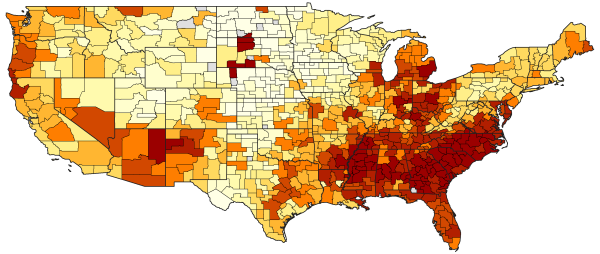In reporting about a rigorous statistical analysis showing different rates of intergenerational income mobility, NYT leads with stuff they just made up.
 Monday, July 22, 2013 at 01:00PM
Monday, July 22, 2013 at 01:00PM Today's NYT top-right front page story, Geography Seen as Barrier to Climbing Class Ladder, devotes a lot of space including a graphic based on the following map to a new study, The Economic Impacts of Tax Expenditures Evidence from Spatial Variation Across the U.S. by some pretty eminent young economists at Harvard and Berkeley.

The graphics and the paper show there were indeed substantial differences in intergenerational income mobility between 1980-81 and 2010-11 depending on where the younger generation lived at age 16, i.e., in 1996-97. The story leads with an anecdote about the long commute of a part-time worker in Atlanta and says "this geography appears to play a major role in making Atlanta one of the metropolitan areas where it is most difficult for lower-income households to rise into middle class and beyond according to a new study that other researchers are calling the most detailed yet of income mobility in the United States." But that is just plain wrong—the study doesn't say anything remotely like that and the researchers apparently did not even look at commuting distances, mass transit availability, or other geography issues. These are their key findings in the Executive Summary:
We find substantial variation in mobility across areas. Our measures of mobility are not significantly affected by accounting for differences in cost-of-living. We do find higher rates of upward income mobility in areas with high rates of economic growth over the past decade, but the vast majority of the difference in mobility across areas is unrelated to economic growth. Hence, we believe our statistics provide a reasonably accurate picture of prospects for upward mobility across areas for children raised in the 1980's and 1990's.
Using the statistics we constructed, we turned to the question of whether the differences across areas in relative and absolute mobility are driven by tax expenditures. We found a significant correlation between both measures of mobility and local tax rates – which are tax expenditures for the federal government because they are deductible from federal income taxes. We found a weaker correlation between state EITC policies and rates of intergenerational mobility.
Although tax policies may account for some of the variation in outcomes across areas, much variation remained to be explained. To understand what is driving this variation and better isolate the effects of the tax expenditures themselves, we considered other sets of factors that have been proposed in prior work. Here, we found significant correlations between intergenerational mobility and income inequality, economic and racial residential segregation, measures of K-12 school quality (such as test scores and high school dropout rates), social capital indices, and measures of family structure (such as the fraction of single parents in an area). Each of these correlations remained strong even after controlling for measures of tax expenditures. Likewise, local tax policies remain correlated with mobility after controlling for these other factors.
We caution that all of the findings in this study are correlational and cannot be interpreted as causal effects. For instance, areas with high rates of segregation may also have other differences that could be the root cause driving the differences in children's outcomes. What is clear from this research is that there is substantial variation in the United States in the prospects for escaping poverty. There are some areas in the U.S. where a child's chances of success do not depend heavily on his or her parents' income. Understanding the features of these areas – and how we can improve mobility in areas that currently have lower rates of mobility – is an important question for future research that we and other social scientists are exploring. To facilitate this ongoing research, we have posted the mobility statistics by area and the other correlates used in the study on our website.
Regrettably, several in the economics blogosphere are taking seriously the NYT invention that commuting distances are the main cause of low intergenerational income mobility. The study itself is worthy and no doubt advances our understanding of some of the actual causes, but the NYT story is a distraction.
 Skeptic
Skeptic
Giving David Leonhardt his due, he has put up a blog post that uses the study in more meaningful ways. http://economix.blogs.nytimes.com/2013/07/25/the-complex-story-of-race-and-upward-mobility/ In particular, he shows that the map of immobility resembles the map of race.

He also points out that the term commuting zone was adopted by the study authors. Why? My speculation is that they did not have enough data to investigate incomes on a smaller scale such as MSAs or zip codes. For technical reasons, I suspect, they needed to use larger areas but did not need to go as large as whole states. Using metropolitan areas or "commuting zones" therefore was not a judgment that commuting times, public transportation, land use planning, etc. were actually likely to affect upward mobility. In any event, they did not report any such finding in the Executive Summary.


Reader Comments